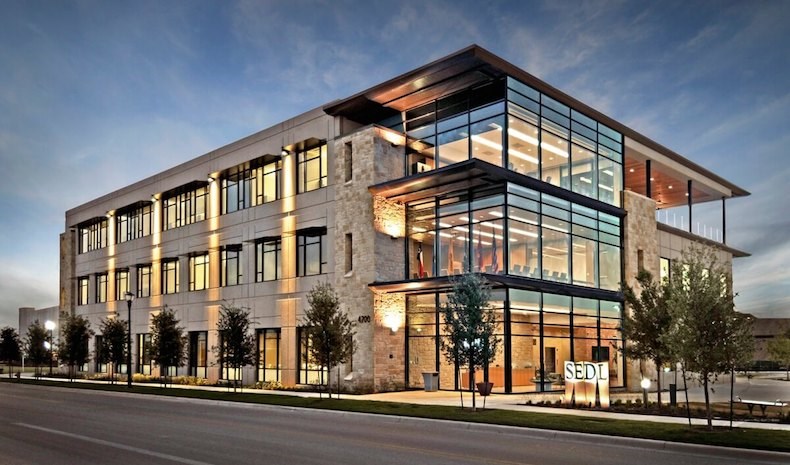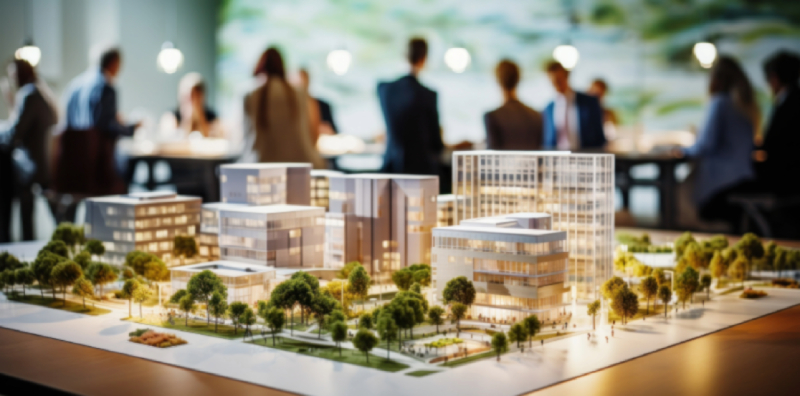Exactly How Commercial Architects Can Transform Your Service Area With Specialist Design Services
Commercial architects play a necessary duty in improving organization settings. Their experience in design can substantially improve both performance and appearances. By creating spaces that reflect a brand's identity, they improve functional performance and staff member fulfillment. The influence of their job expands past simple appearance. Comprehending the nuances of collaboration and sustainability can bring about transformative results. What details components make these changes effective?
Comprehending the Role of Commercial Architects
Commercial architects play a vital duty fit business atmospheres that are both useful and cosmetically pleasing. They specialize in making spaces tailored to the particular demands of businesses, making certain that every square foot is used properly. These professionals integrate aspects such as spatial layout, illumination, and materials to enhance productivity and worker health. By working together with clients, industrial architects gather insights into operational demands and brand name identity, translating these into innovative designs.Additionally, they navigate complicated building codes and zoning laws, making sure conformity while making the most of style capacity. Their expertise prolongs to sustainability methods, promoting energy effectiveness and ecologically pleasant materials in their projects. Through their creative vision and technological expertise, commercial architects not only produce enticing rooms but also foster environments that promote partnership and growth. Inevitably, their payments significantly affect the general success and photo of a business.
Benefits of Professional Layout Services

Customizing Spaces to Your Brand Identity
Customizing spaces to a brand name's identification is important for communicating its core values and objective. Commercial architects play a crucial duty in boosting a business's visual identity with thoughtful style options. By lining up building aspects with brand principles, companies can create environments that resonate with clients and employees alike.
Showing Brand Values
Exactly how can a well-designed area symbolize a business's core values? Commercial architects play a critical duty fit environments that reverberate with a brand's identity. By integrating elements such as color design, products, and designs, they create rooms that mirror the essence of the company. For instance, a technology business may go with open formats and contemporary furnishings to communicate advancement and collaboration, while a high-end brand might choose classy surfaces and intimate areas to evoke exclusivity and sophistication. Thoughtful style not only enhances performance but additionally fosters a solid connection in between employees, customers, and the brand. Inevitably, a well-crafted environment acts as a concrete depiction of a company's mission and vision, enhancing its values at every touchpoint.
Enhancing Aesthetic Identification
What elements can properly elevate a brand's visual identification within a commercial area? Commercial architects play an essential function in incorporating design functions that reverberate with a company's values. Color design, typography, and materials can be purposefully chosen to show brand name values while making sure visual charm. Additionally, integrating logo designs and brand images right into the architecture can create a cohesive aesthetic story. Lights design can better enhance the ambience, leading customer understandings and experiences (commercial architects). Format and furnishings choices must align with the brand's character, whether it's contemporary, typical, or cutting-edge. Ultimately, a properly designed commercial space not only brings in consumers yet likewise reinforces brand acknowledgment, creating an enduring perception that promotes loyalty and engagement
Enhancing Functionality and Efficiency
Enhancing functionality and effectiveness in business rooms includes enhancing area usage and developing process that enhance operations. Architects concentrate on producing layouts that minimize squandered area while promoting smooth adjustments between tasks. This approach not only boosts efficiency however also adds to a much more cohesive workplace.
Optimizing Space Utilization
Reliable room usage is a crucial factor in business design, where the design needs to balance aesthetic appeals with performance (commercial architects). Architects directory use different techniques to take full advantage of available square video while making sure that each area offers an unique function. By evaluating operations, web traffic patterns, and user demands, architects can produce formats that boost both employee efficiency and customer experience. Multi-functional rooms, flexible furniture arrangements, and enhanced storage space options are crucial components in attaining this goal. In addition, incorporating natural light and open spaces promotes an extra inviting environment, further raising the utility of the setting. Ultimately, efficient room utilization not just enhances functional efficiency yet also contributes favorably to the total brand picture, making it a necessary factor to consider in industrial style
Structured Workflow Style
Exactly how can a properly designed workflow transform an industrial room right into a hub of efficiency? Structured operations layout focuses on enhancing the physical layout and operational processes within an organization setting. By strategically organizing workstations, conference locations, and sources, architects can get rid of unnecessary motion and boost collaboration. This thoughtful layout lessens interruptions and promotes communication, allowing staff members to concentrate on their jobs a lot more effectively. In addition, incorporating technology right into the workflow can additionally automate processes, minimizing time invested in routine tasks. As a result, companies experience improved staff member morale and enhanced output, creating a vibrant ambience that promotes advancement. Eventually, buying streamlined operations style not only improves performance but additionally places an industrial space for lasting development and success.
Fostering Collaboration Via Style
Contemporary workspaces usually prioritize specific productivity, the layout of industrial spaces significantly highlights cooperation as a crucial chauffeur of technology and team cohesion. Architects play a crucial role in developing environments that promote communication among staff members. Open formats, multifunctional rooms, and strategically put public areas encourage spontaneous conversations and brainstorming sessions.Incorporating aspects such as movable furniture and adaptable conference spaces permits teams to reconfigure spaces based on their joint needs. In addition, incorporating modern technology, like interactive whiteboards and video conferencing tools, improves the capacity to connect effectively, no matter location.Natural light and biophilic style components additionally contribute to a more inviting atmosphere, promoting comfort and well-being, which are crucial for productive team effort. By concentrating on these elements, business architects can develop vibrant environments that not only improve partnership however likewise drive general service success.
Lasting Design Practices in Commercial Architecture
 click to read architects
click to read architects"/>
Case Studies: Successful Makeovers by Commercial Architects
The implementation of sustainable design methods has not only improved the strategy to commercial architecture however has actually also resulted in impressive transformations in different organization rooms. One notable case is the redesign of a tech business's headquarters, where architects incorporated natural light and eco-friendly walls, leading to enhanced employee well-being and productivity. This transformation decreased energy costs by 30% and enhanced the company's public image.In another instance, a retail store undertook a full overhaul, making use of redeemed products and energy-efficient systems. This not only brought in eco-conscious consumers yet likewise raised foot traffic by 25%. A third case involved a corporate workplace that welcomed an open-plan format with flexible work areas, promoting cooperation amongst teams. The architects' focus on developing a vivid and versatile setting significantly boosted worker fulfillment. These study exhibit just how business architects can produce impactful spaces that straighten with company goals and sustainability initiatives.
Regularly Asked Concerns
Just How Much Do Commercial Architecture Provider Commonly Expense?
The cost of industrial architecture solutions varies extensively, normally ranging from $100 to $250 per hour. Factors affecting pricing consist of project intricacy, location, and the engineer's experience, making it vital for businesses to acquire comprehensive quotes.
What Sorts Of Organizations Profit A Lot Of From Commercial Architects?
Various services, consisting of retail, hospitality, and corporate offices, significantly advantage from commercial architects. These experts boost functionality, looks, and brand identification, ensuring spaces are enhanced for consumer engagement and worker efficiency, inevitably fostering company development.
The length of time Does an Industrial Layout Project Typically Take?
The timeline for an industrial style task generally varies from numerous weeks to several months. Elements influencing period consist of task intricacy, governing authorizations, and collaboration among stakeholders, all of which can affect general conclusion time.
Can I Work With a Business Engineer for Renovations Only?
Yes, hiring an industrial designer for restorations is viable. Many architects specialize in renovation projects, providing expertise in maximizing existing areas while adhering to laws and enhancing functionality, visual appeals, and overall value of business atmosphere.
What Certifications Should I Search for in a Commercial Architect?

Comments on “commercial architects FAQs: Answers to the Most Common Client Questions”